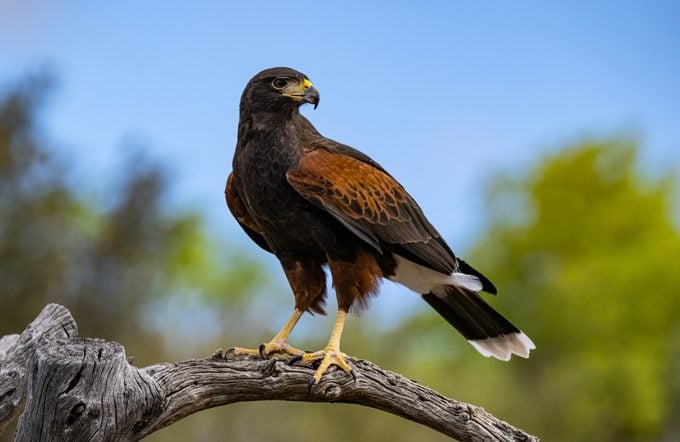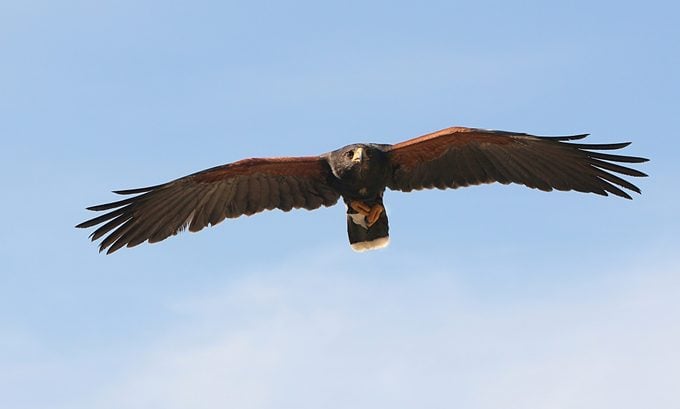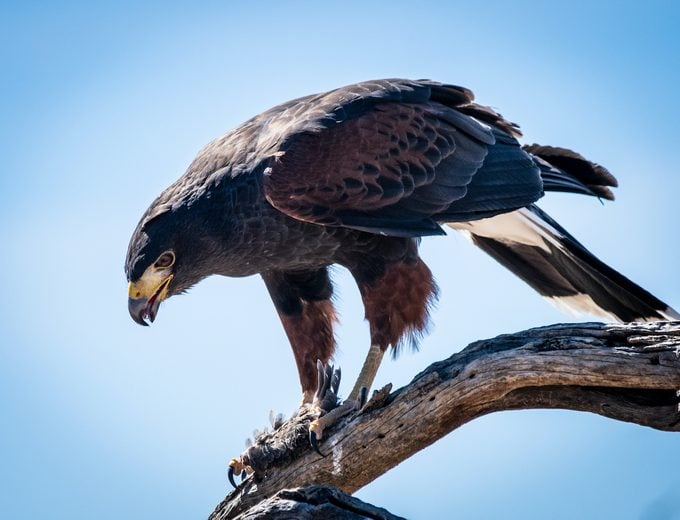How to Identify a Harris’s Hawk
Updated: Jul. 10, 2024
If you see dark-colored raptors in the southwestern desert, you might've spotted Harris's hawks. Find out why they're known as 'wolves of the air.'
On This Page
What Does a Harris’s Hawk Look Like?

When looking up at a soaring Harris’s hawk from below, you’ll likely notice plenty of brown feathers. Named for naturalist Edward Harris, these birds’ main coloring is dark brown. If you’re able to look closer with binoculars, you’ll spot reddish, rust-colored feathers at the shoulder. Its tail has white at the tips of the feathers, its beak is yellow, and the bird’s overall size is about that of a crow.
Females and males appear identical, but juveniles have some distinct differences. While adults are brown overall with rusty patches on the shoulders, immature birds have white streaks on their chests, and tail feathers are streaked white and brown as well. When flying, immature Harris’s hawks have some white patches near the tips of the wings.
Learn about more types of hawks you should know.
Harris’s Hawk Range and Habitat

If you live in the southwestern United States, you have a good chance of finding Harris’s hawks. They’re year-round residents of most of the lower half of Texas, as well as southern Arizona and a very small section of the Arizona-California border.
Most commonly, you’ll find a Harris’s hawk in saguaro deserts and brushlands. In some sections of their range, Harris’s hawks appear along rivers and even in suburban areas.
With these hawk identification tips, you’ll never have to wonder which bird you saw.
Diet: What Does a Harris’s Hawk Eat?

Like other hawks, Harris’s hawks are mostly carnivorous. They’ll hunt rabbits, rats, birds, and even lizards. Unlike other hawks, they can flock together in groups of up to seven birds and hunt as a group, which serves as another key to identification for a bewildered birder.
“This a Harris’s hawk (above), one member of a family group that lives and hunts together at the Arizona-Sonora Desert Museum in Tucson, Arizona. They hunt cooperatively and have been called the ‘wolves of the air’,” says Birds & Blooms reader Terry Kanago.
Learn how to identify a red-tailed hawk.
Nesting Habits
These hawks nest on tall structures ranging from cliffs, to trees, to man-made structures such as electrical towers. Nests are constructed from sticks and cacti components and are about two feet across. A female lays a clutch of one to five eggs, which will be incubated for about five weeks. After about nine weeks, the young birds leave the nest.
Head west to see a Ferruginous hawk.
Calls and Sounds
Harris’s hawks give a croaking, guttural call that lasts several seconds.
Bird sounds courtesy of the Cornell Lab of Ornithology
Next, find out where to look for Swainson’s hawks.




















